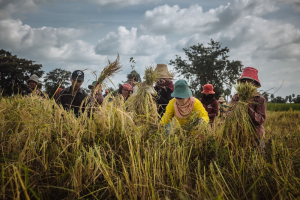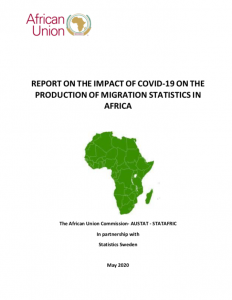Mobility restrictions have affected migrants´ ability to move
Mobility restrictions and border closures have affected migratory journeys, especially in the first half of 2020. Flows registered through key transit points in West and Central Africa between January and May decreased by 39 per cent. During the first six months of 2020, estimated overall irregular arrivals to Europe decreased by around 25 per cent compared with the same period in 2019, when irregular arrivals were already much lower than in previous years. However, movements resumed in May, based on available data from IOM’s Displacement Tracking Matrix (DTM). Restrictions seem to have led some migrants to search for alternative routes, thereby increasing their exposure to risks such as labour and sexual exploitation. They have also affected migrants´ ability to move by limiting their access to work opportunities and other ways to finance onward mobility. The Mixed Migration Centre (MMC) recently found that aspirations to migrate in some West African countries became more common since the start of the pandemic, while capabilities to migrate were reduced. Mobility restrictions have also limited the ability of migrants to conduct home visits, with a strong impact on transnational families. At the same time, family reunification procedures in Europe have been delayed because of disruptions to face-to-face services.
Socioeconomic restrictions have put livelihoods at risk
Socioeconomic restrictions have put the livelihoods of many people on the move and of longer-term migrants at risk. Migrants who have arrived more recently, or those with irregular status, precarious working conditions and limited access to information or support networks are more likely to face income declines and a deterioration of their living conditions. According to MMC data, around half of the migrants interviewed in May in North and West Africa suffered losses of income and were less able to afford basic goods and send remittances back home. Such losses are also likely to worsen migrants´ (often already limited) access to healthcare. While migrants´ access to work opportunities and income appears to have been improving again since June, previous crises have shown that migrants are more exposed than native-born workers to consequences of downturns, such as un- and underemployment and wage declines. The pandemic has so far also particularly affected sectors with a high concentration of migrant workers. In addition, social safety measures adopted by governments to mitigate the impact of job losses have often not included migrants.
Remittances are likely to become even more important
Migrants facing such difficulties find it harder to send remittances. This is particularly worrying, as remittances could help households to cope with the effects of the pandemic, such as income losses and health services costs. In times of crisis, remittances often act as an insurance mechanism and therefore tend to increase. However, the current crisis is likely to be more severe than previous ones and to simultaneously affect countries of origin, transit and destination. Lower remittance transfers may put livelihoods and health and education outcomes in countries of origin at risk.
At the same time, the relative importance of remittance flows as a source of external financing for West and North African countries is likely to increase. The World Bank estimates that remittances to Sub-Saharan Africa will decrease by 9 and 6 percent respectively in 2020 and 2021, and remittances to the Middle East and North Africa by 8 percent each year. However, official development assistance and foreign direct investment will probably decline even more, due to factors such as travel restrictions, investment and trade slowdowns, and changed priorities for donor countries.
Destination countries need migrant workers
The pandemic has also highlighted the dependence of destination countries’ economies on migrant workers. As border closures and lockdown measures were implemented, some European countries were faced with the need to facilitate migrants´ access to the labour market and their contribution to essential economic sectors, such as health and food industries. While migrant labour needs may decrease in the short term due to the economic downturn, they are likely to increase again in line with longer-term demographic and labour market needs. In addition, COVID-19 outbreaks among migrants living and working in precarious conditions are a stark reminder that “no-one is safe until everyone is safe.”
International policies need to be preserved
Finding a balance between the need to restrict movements across countries and the importance of preserving international policies and regional agreements on free movement has been challenging, as recalled by the African Union in April and by the United Nations in June 2020. However, preserving international laws and conventions is of upmost importance. Recent research has furthermore suggested that the case for mobility restrictions to control pandemics may be weak. It has been equally challenging to balance health safety measures with measures intended to preserve livelihoods and economies, which in these regions rely heavily on cross-borders movements and trade. Many migrants have built their social and economic strategies and networks on international policy frameworks allowing them specific mobility rights. The impact of mobility restrictions on such strategies and networks needs to be carefully considered and appropriate safeguards need to be put in place.
Addressing migrants´ vulnerability will be key to recovery from the pandemic
The COVID-19 pandemic has exacerbated the vulnerability of migrants from West and North Africa to risks and crises. It has shown that a better inclusion of the needs and rights of migrants in national and transnational policies and agreements is urgently needed. Key aspects to be considered include international labour standards, access to health care and education, and facilitation of remittance transfers. The limited availability of comprehensive, timely and disaggregated data can hinder the identification of targeted policy and programmatic measures. Addressing these points is essential to increase the resilience to risks and crises not only of migrants, but also of their communities, as well as of societies at large in countries of origin and destination.












